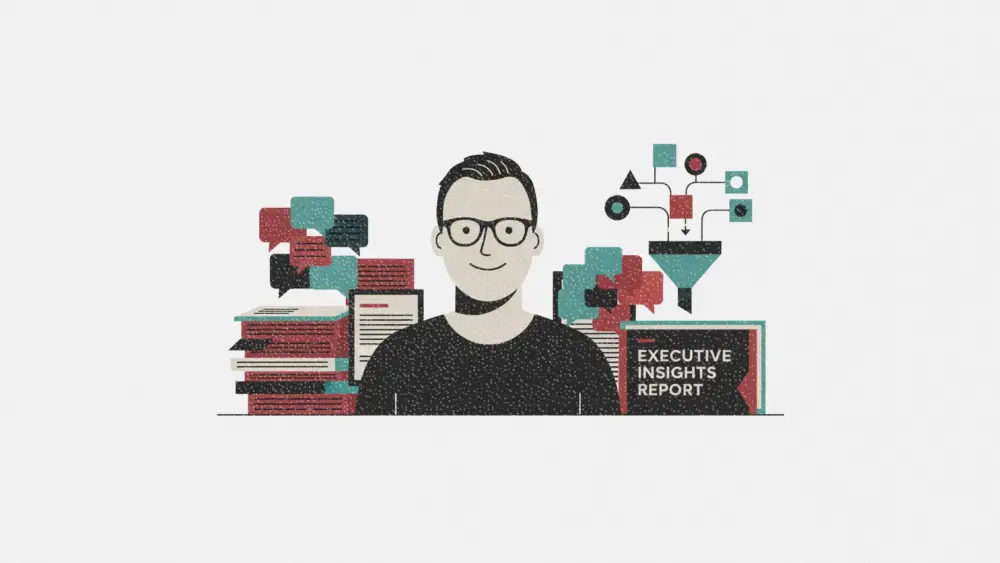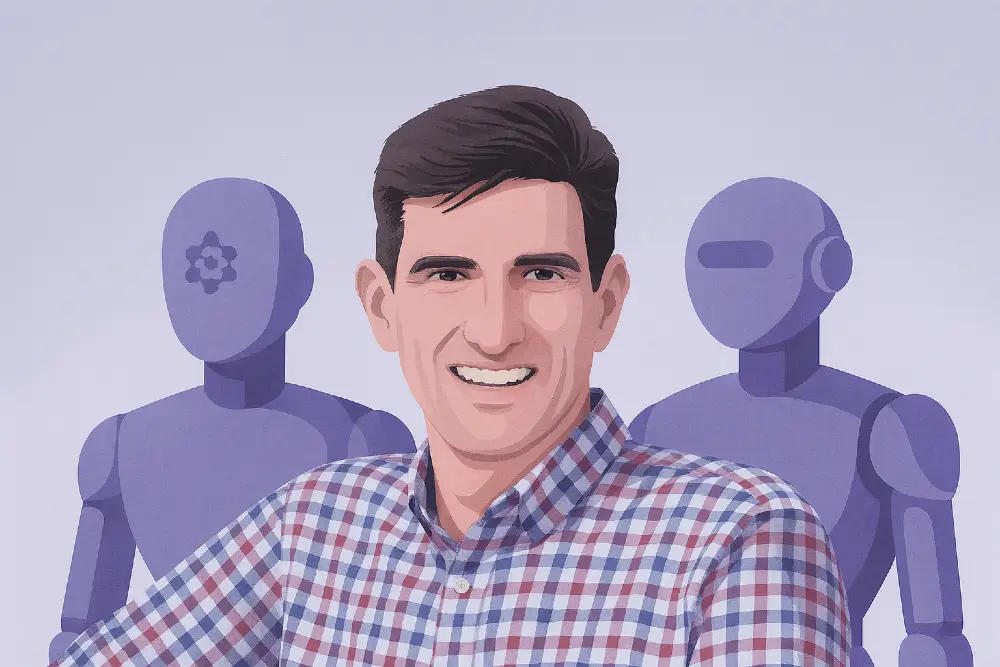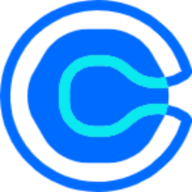How a B2B content writer turned 25 executive interviews into a flagship report in half the time
B2B content strategist Nick Pryke shares his systematic approach to extracting insights from large-scale interview projects using AI, without sacrificing the human nuance that makes enterprise content work.

Most B2B marketers struggle with a familiar bottleneck: turning hours of executive interviews into polished, strategic content. Nick Pryke found a way to cut that time in half—without losing the human insight that makes enterprise content valuable.
Nick is the founder of The Glue Between, a content consultancy specializing in long-form B2B content and account-based marketing campaigns for mid-to-large enterprise clients. Since launching in 2022, he has delivered content for 162 of the Fortune 500 companies and currently sits on a Global Writer's Panel for one of the Big Four consultancies.
His experience runs deep. Before founding The Glue Between, Nick served as Creative Director at GDS Group, leading cross-functional teams of 42 people across six functions. He's conducted over 1,200 executive interviews throughout his career, hosted 250+ virtual roundtables and 30 in-person events, and previously worked as a Senior Editor and presenter covering digital transformation topics.
His system uses AI operationally rather than creatively, focusing on the labor-intensive tasks that don't require human judgment.
Speaking with ContentGrip, Nick shares his systematic approach to processing large-scale interview projects, the tool stack that powers his workflow, and what separates high-performing enterprise content from generic material.
Short on time?
- How Nick uses AI to process 25+ executive interviews
- The quote matrix system explained
- Strategic advice for turning interviews into content
- The minimal AI tool stack that works
- What separates great enterprise content from mediocre material
How Nick uses AI to process 25+ executive interviews
When Nick took on a flagship regional report requiring 25 executive interviews, he faced a familiar challenge: how do you extract actionable insights from hundreds of pages of transcript without drowning in the details?
His solution started with structure. Before conducting a single interview, he built a content blueprint—a granular breakdown of key messages, pain points, and perspectives that would inform each chapter of the report.
The client's account leads conducted 45-minute conversations with each executive while Fathom recorded and transcribed everything. Each interview generated 20+ pages of transcript.
Rather than manually reading through 500+ pages, Nick built a training system in ChatGPT. He fed it three layers of information: the campaign overview, the detailed content blueprint, and a single interview transcript to train on.
The training process took a day and a half. Initial accuracy was around 30%. Through iterative training, he pushed it to 80%. "The reason I was fine with that was because I was always going in as the human to quality check, to refine, and to cross-check against the original transcript," he notes.
Once training was complete, he processed the remaining 23 transcripts. The output: a master quote matrix with over 500 usable, verified quotes organized by interviewee and chapter. What would have taken a full working week took two and a half days.

The quote matrix system explained
The quote matrix is deceptively simple: rows for interviewees, columns for report chapters, cells containing relevant quotes. But its power lies in how it transforms unstructured interview data into strategic raw material.
Nick built the matrix outside of ChatGPT, in Excel. This separation was intentional—ChatGPT's hallucination rate was too high when asked to build the matrix directly. Instead, he trained the AI to extract quotes from individual transcripts, then manually verified and populated the matrix himself.
The matrix structure forced discipline. Each cell required a minimum of three quotes per chapter, creating a bank of options for any given section of the report. When drafting, Nick could quickly scan relevant quotes, select the most impactful ones, and weave them into the narrative.
The quality control process remained entirely human. Nick cross-checked each extracted quote against the original transcript. "I trained the AI to ensure that it's only using verbatim quotes directly from the transcript," he says. "At the beginning, it was hallucinating and making assumptions about what things were being referenced."
The matrix is the operational backbone of Nick's system. But long before he reaches that point, another crucial phase determines whether the entire workflow succeeds or fails: the interview itself.
Strategic advice for turning interviews into content
The quality of interview-based content starts well before the recording begins. Nick's approach centers on preparation and boundaries.
"Their deadlines are tight, their schedules are full," he explains, referring to the C-suite executives who provide technical insight. "You're not just working to your own campaign deadlines, you're also working to the availability of those subject matter experts."
This time pressure demands clarity. Nick recommends starting with five focused questions, not fifteen sprawling ones. "Be very clear with what you want to ask in that interview and why," he advises. "Because if you can't get those two things right first off the bat, you're not ready to do that interview anyway."

Send questions in advance, but frame them as guidelines for conversation, not a script. Set clear expectations: 45 minutes maximum, recorded with consent, with a specific objective outlined.
The post-interview workflow matters as much as the interview itself. Ask one final question that consistently yields gold: "What are you most excited about in this area?"
"It's not about scrambling before time," Nick says. "It's about clear planning, clear interview questions, knowing what gaps you want to fill."
With the interview preparation and execution framework in place, the next question becomes: which AI tools actually power this workflow?
The minimal AI tool stack that works
Nick's AI toolkit is deliberately sparse: Fathom, ChatGPT, and occasionally Claude.
"I like to keep things simple," he explains. "I prefer to go deep in my understanding and build my knowledge in a few platforms. With the emergence of an app for everything and AI can do anything, you can get lost in the noise very quickly."
Fathom records, transcribes, and provides exportable transcripts. ChatGPT handles operational content work: ideation, research, transcript analysis, and quote extraction. Claude enters the picture for narrative work.
"Claude I use more for shaping narrative, rough draft, bouncing ideas around storytelling," Nick explains. "Claude just has a higher level of capability when it comes to content creation and content writing."
This division is strategic. ChatGPT excels at following systematic processes. Claude performs better at maintaining voice and narrative flow. Neither tool produces final content—Nick estimates that 70% of the work remains human after AI generates initial drafts.
"The remaining 70% of that work is down to me as a human to then bring that to life and find those illogical and emotive connections that AI is not capable of doing," he explains. This is where the strategic thinking, nuanced judgment, and authentic voice come through—elements that can't be systematized or automated.
The tools are simple, the process is systematic. But Nick's experience working across hundreds of Fortune 500 projects reveals something less obvious: what actually makes enterprise content perform.

What separates great enterprise content from mediocre material

After working with 162 Fortune 500 companies, Nick has observed a consistent pattern: the best enterprise content does less, not more.
"It's trying to do too much with one asset," he explains. "What starts as a focused spotlight on one specific topic becomes a muddied tour of multiple capabilities."
This mission creep dilutes impact. Readers who came for deep insight on a particular challenge get confused by the detour.
The second differentiator is willingness to provide genuine perspective. "How do we use our subject matter experts to provide insights that aren't just generic?" Nick asks. "What are we doing different? What are we aware of that we want to share?"
Enterprise clients often play it too safe. "Those that don't do that, their content tends to perform higher because they're providing their own unique perspective."
The ideal interview count: three. Two internal subject matter experts and one customer voice. This principle underpins Nick's own content product, iLABs (Insight-Led Authority Building Content)—an eight-week process that culminates in a fully branded, marketing-ready hero asset using a maximum of three subject matter experts.
His recent 25-interview project was the exception—driven by a specific goal to build a community. For standard reports, less is more.
Nick's recent work includes content strategy and writing for TXOne Networks' ABM campaign and Moneyhub's hero asset with landing page.
Key takeaways for B2B marketers
Nick's advice focuses on operational adoption rather than creative replacement. "Focus on one specific area operationally first within content marketing that AI can potentially enhance productivity in," he recommends.
This operational-first approach differs from the common pattern of jumping straight to AI-generated blog posts or social content. "Lower hanging fruit of blog writing, sure," Nick acknowledges. "But if you're just doing that for SEO purposes, ChatGPT, Claude, use that. Because that's not really the game anymore."
The real value lies in the labor-intensive, repeatable tasks that drain marketer time without requiring creative judgment. Transcript analysis. Quote extraction. Research compilation. These operational layers, when systematized with AI, free up human capacity for strategic and creative work.
"The floor belongs to AI, the ceiling belongs to us," Nick quotes, referencing Jason Ng, CMO of Typeface. "There will always be room for us as humans, creatively, operationally, in terms of our purpose."
That division of labor—AI handling the operational floor, humans pushing the creative ceiling—may be the most sustainable path forward for B2B content teams.





